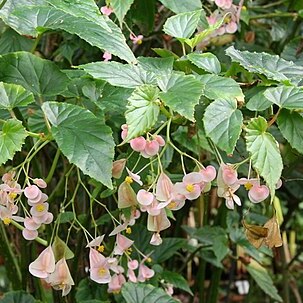Herbs, annual or perennial [canelike shrubs, rarely treelets, rarely climbing, sometimes epiphytic], evergreen [some tuberous species seasonally absent, notably Hillebrandia], ± succulent, usually hairy or scaly, sometimes glabrous. Leaves alternate in 2 ranks connate]; staminate flowers: tepals 2–4[–6, rarely more; 5 sepals and 5 petals in Hillebrandia], stamens [3–]6–33[–100+], distinct [filaments basally connate], [sometimes collectively bilaterally symmetric]; pistillate flowers: tepals [2–]4–5[+] [5 sepals, 5 petals in Hillebrandia], ovary inferior [semi-inferior in Hillebrandia], [2–]3[–9]-carpellate, [1–]3[–6]-winged [horned, ribbed, or angled, rarely not winged], wings unequal, [2–]3[–6]-locular [5-locular basally and ± 1-locular distally in Hillebrandia], placentation axile [axile and parietal in Hillebrandia] (placentae often 2-lobed), styles [2–]3[–9; 5 in Hillebrandia], distinct [rarely basally connate], stigmatic branches [4–]6[–12+], usually twisted [straight], ovules 15–50 per locule, anatropous, bitegmic, crassinucellate. Fruits capsular [baccate], winged [horned, ridged, or angled, rarely not winged, notably in Hillebrandia], papery [rarely fleshy], dehiscence loculicidal [indehiscent]. Seeds 25–100+, operculate (lid surrounded by collar cells), embryo straight, endosperm insubstantial or absent.
Perennial succulent herbs, very rarely subshrubs. Stem erect, frequently rhizomatous, or plants tuberous and either acaulescent or shortly stemmed, rarely lianoid or climbing with adventitious roots, or stoloniferous. Leaves simple, rarely palmately compound, alternate or all basal, petiolate, stipules usually deciduous; blade often oblique and asymmetric, rarely symmetric, margin irregularly serrate and divided, occasionally entire, venation usually palmate. Flowers unisexual, plants monoecious, rarely dioecious, (1 or)2-4 to several, rarely numerous in dichotomous cyme, sometimes in panicles, with pedicel and bracts. Staminate flower: tepals 2 or 4 and decussate, usually outer ones larger, inner ones smaller; stamens usually numerous; filaments free or connate at base; anthers 2-celled, apical or lateral. Pistillate flower: tepals 2-5(-10), usually free, rarely connate at base; ovary nodding, pendulous, or ascending, 1-3-, rarely 4-8-loculed; placentae axile or parietal; styles 2 or 3(or more), free or fused at base, forked once or more; stigma turgid, spirally twisted-tortuous or U-shaped, capitate or reniform and setose-papillose. Capsule dry, sometimes berrylike, unequally or subequally 3-winged, rarely wingless and 3-or 4-horned; seeds very numerous, minute, oblong, testa pale brown, reticulate.
female flowers: tepals ± as in male, rarely 6–9; staminodes absent or very small; ovary inferior, (1)2–4(6)-celled, usually angled or winged; styles 2–6, free or connate, usually bifid but occasionally multifid, branches stigmatic and often twisted; placentation axile or rarely (Hillebrandia) parietal, placentae entire or lobed; ovules very numerous
Female flower: perianth more or less as in the male; staminodes absent or very small; ovary inferior, 2–4-(rarely 1-) celled, mostly angled or winged; styles 2–5, free or connate; stigmas often twisted, papillose all over; ovules very numerous, on axile projecting simple or lobed placentas
male flower: tepals 2–5, free or connate; stamens ?, filaments free or rarely connate; anthers 2-celled, continuous with the filament, opening lengthwise or rarely by apical pores; rudimentary gynoecium absent
Male flower: sepals 2, opposite, rarely 5, valvate; petals imbricate or absent; stamens numerous, filaments free or connate, anthers 2-celled, continuous with the filament, opening lengthwise
Flowers monoecious, actinomorphic or zygomorphic, in terminal or axillary cymes, conspicuous; sepals and petals usually not distinguished
Fruit a capsule or berry; seeds minute and very numerous, with reticulate testa, little or no endosperm and straight embryo
Leaves alternate, simple or very rarely pinnate, often asymmetric; stipules free, persistent or deciduous
Seeds minute and very numerous, with reticulate testa, scanty or no endosperm and straight embryo
Leaves alternate, simple, often unequal-sided or oblique; stipules free, deciduous
Flowers monoecious, actinomorphic or asymmetric, mostly in axillary cymes, showy
Herbs or undershrubs, mostly succulent
Herbs or subshrubs, usually fleshy
Fruit a capsule or berry

